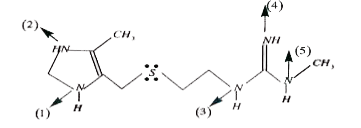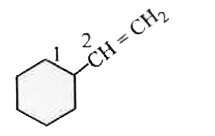C1−C2 bond is shortest inSolution in Telugu
A. 
B. 
C. 
D. 
The correct Answer is:B
Topper's Solved these Questions
- ELECTRONIC EFFECTS AND REACTION INTERMEDIATESBOOK - AAKASH SERIESCHAPTER - ELECTRONIC EFFECTS AND REACTION INTERMEDIATESEXERCISE - ADDITIONAL PRACTICE EXERCISE (LEVEL - II (LECTURE SHEET ADVANCE)) (Straight ObjectiveType Questions)
10 Videos
- ELECTRONIC EFFECTS AND REACTION INTERMEDIATESBOOK - AAKASH SERIESCHAPTER - ELECTRONIC EFFECTS AND REACTION INTERMEDIATESEXERCISE - ADDITIONAL PRACTICE EXERCISE (LEVEL - II (LECTURE SHEET ADVANCE)) (More than One correct answer Type Questions)
11 Videos
- ELECTRONIC EFFECTS AND REACTION INTERMEDIATESBOOK - AAKASH SERIESCHAPTER - ELECTRONIC EFFECTS AND REACTION INTERMEDIATESEXERCISE - PRACTICE SHEET ( EXERCISE-III (LEVEL-II (ADVANCE)) (Integer Type Questions)
6 Videos
- ELECTRON MIGRATION EFFECTS BOOK - AAKASH SERIESCHAPTER - ELECTRON MIGRATION EFFECTS EXERCISE - QUESTIONS FOR DESCRIPTIVE ANSWERS
10 Videos
- ELEMENTS OF BORON FAMILYBOOK - AAKASH SERIESCHAPTER - ELEMENTS OF BORON FAMILYEXERCISE - OBJECTIVE EXERCISE - 3
7 Videos
Similar Questions
Consider the basicity of the following aromatic amines:
(I) aniline (II) p-nitroaniline (III) p-methoxyaniline (IV) p-methylaniline
The correct order of decreasing basicity is:
View SolutionResonance energy will be more if
View SolutionOn mono protonation which nitrogen of the following compound can be protonated.

View SolutionHyperconjugation effect is also termed as 'no bond resonance'. Why?
View SolutionWhich one of the following compounds is not a protonic acid ?
View Solution(C_(0)+C_(1))(C_(1)+C_(2))(C_(2)+C_(3))(C_(3)+C_(4)).........(C_(n-1)+C_(n))=(C_(0)C_(1)C_(2).....C_(n-1)(n+1)^(n))/(n!)
View SolutionC_(0)C_(1)+C_(1)C_(2)+C_(2)C_(3)+...+C_(n-1)C_(n)
View SolutionProve that (C_(0)+C_(1))(C_(1)+C_(2))(C_(2)+C_(3))(C_(n-1)+C_(n))=((n+1)^(n))/(n!)*c_(0)*C_(1)*C_(2).........
View SolutionIf (1+x+x^(2))^(n)=(C_(0)+C_(1)x+C_(2)x^(2)+.........) then the value of C_(0)C_(1)-C_(1)C_(2)+C_(2)C_(3)...
View SolutionIn but-1, 3-diene the C2−C3 bond length is
View Solutionin C_(1)-H, C_(2)-H and C_(3)-H the homolytic bond dissociation energy order is :
View Solution(C0+C1)(C1+C2)(C2+C3)....(Cn−1+Cn)=
View SolutionIf C0+C1+C2+......+Cn=128 then C0−C12+C23−C34+......=
View SolutionIf C0,C1,C2,…,Cn are the binomial coefficients in the expansion of (1+x)n⋅n being even, then C0+(C0+C1)+(C0+C1+C2)+….+(C0+C1+C2+…+Cn−1) is equal to :
View SolutionWhich of the following statements are correct for butadiene
4CH2=3CH−2CH=1CH2
(1) The C1−C2andC3−C4 bonds are longer than a carbon double bond.
(2) The C1−C2andC3−C4 bonds are shorter than a carbon - carbon double bond.
(3) The C2−C3 bond is slightly shorter than a carbon - carbon single bond.
(4) The C2−C3 bond is slightly longer than a carbon - carbon double bond.
View SolutionC1−C4 glycosidic bond is NOT found in
View Solution

